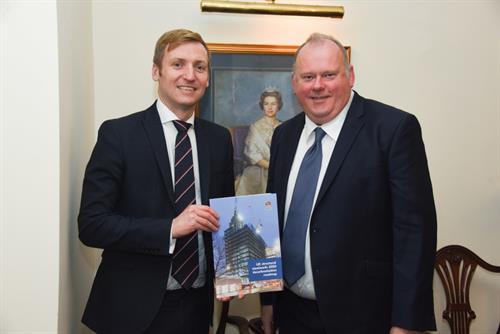
BCSA News and Insights
President's Column January 2022
13/01/2022
Category: President's Column
Late last year BCSA published its 2050 Decarbonisation Roadmap that sets out how the UK constructional steelwork sector will transition to net-zero by 2050. It will be a complex journey involving a diverse mix of innovative technologies and is based on six decarbonisation strategies, or 'levers', that the sector will develop and deploy concurrently. But, it is achievable and shows how a genuinely circular and sustainable net-zero carbon structural steel sector will be in place by 2050, with substantial progress achieved by 2030. It was good to end the year on such a positive note with hope for the future, particularly after the year we've all just had.
One of those 'levers', and one that has the potential to deliver a quick win, is improving design efficiency, with a carbon reduction target of 17.5%. In this day and age, with 3D design engines and a fiercely competitive market, it seems strange to think that our structures are over designed by 17.5%. But there are certainly things that can be improved such as reducing over-specification of design loads, optimising section sizes and using S460 steel where appropriate.
What this 'lever' is definitely not about is absolute minimum weight design. As we have known for years, minimum steel weight does not equal minimum cost, and the same goes for carbon. If you slim your sections down too much, then connections become complex and more temporary works are required for steel erection, costing more money and carbon - a point I made in my column last time.
What this 'lever' is about is carbon-optimised design or design for sustainable construction, a holistic approach to minimise overall carbon. With this in mind, BCSA and SCI are currently working on a new design guide that sets out all of the issues to consider in order to achieve an optimised design.
I look forward to reading that publication, but what I know will be required for optimised designs is time, more time for designers to think through the issues and consider the implications of design decisions on serviceability, constructability, adaptability, longevity and potential for reuse and recycling.
Today, even with email, extranet sites and BIM, many projects suffer from a lack of timely and complete information, which impacts on the number and value of variations often at a late stage. This tells me that designers need more time from their clients already, even before we start thinking about achieving carbon-optimised designs. We all know that late design changes have a disproportionate effect on cost, but the same goes for carbon in terms of wasted fabrication, inefficient transportation and disrupted erection sequencing.
So, as I look forward to 2022, with some optimism due to the buoyant state of our industry, I have three wishes for the construction genie. Firstly, we all want to minimise carbon on our projects, so clients please allow our designers the time to achieve that. Secondly, designers, please use that time wisely when optimising your designs, and think how your design will be built. Lastly, please engage with steelwork contractors and other relevant Tier 2 contractors early in the design process, as I see that as essential to achieve carbon optimised designs.
Happy New Year to you all.
Mark Denham, BCSA President

Previous article
25/11/2021

Structural steelwork announces net-zero carbon Roadmap with visit from special guest Lee Rowley MP
On November 22nd 2021, the BCSA announced the Roadmap at its Westminster headquarters to an audience including special guest Lee Rowley MP the Minister for Industry, BCSA Chief Executive David Moore said the whole steel sector was agreed that carbon reduction strategies were essential to combat the climate change emergency. "The Roadmap sets out a series of decarbonisation measures that the UK steel and steelwork industries have committed to and agree will achieve our net-zero objectives."...
Next article
13/01/2022

BCSA welcomes new Stakeholder member - Sum ADR
Sum ADR Limited, are construction adjudicators and Quantity Surveyors, regulated by the RICS.


